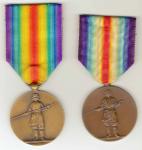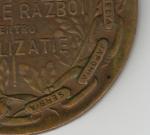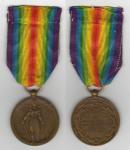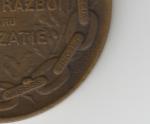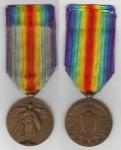-
Posts
1,170 -
Joined
-
Last visited
-
Days Won
1
Content Type
Profiles
Forums
Blogs
Gallery
Events
Store
Everything posted by RobW
-

Romanian Victory Medals
RobW replied to Kev in Deva's topic in Inter-Allied Victory Medals of the Great War
To all, To add to the others posted of late here is another 'official' Romanian vic. This one has the word 'BRONZE' impressed on the edge. Just visible in this scan is the designers name 'Kristesko' on the reverse. Regards, Rob -

Romanian Victory Medals
RobW replied to Kev in Deva's topic in Inter-Allied Victory Medals of the Great War
To all, Here is another 'official' Romanian vic. This one has the word 'BRONZE' inscribed on the edge. Just visible in this scan is the designers name 'Kristesko' on the reverse. Regards, Rob -

French Victory Medals
RobW replied to Kev in Deva's topic in Inter-Allied Victory Medals of the Great War
Here are the close-ups. I am impressed by the level of detail that is here on a mini that is but 11 mm across. Although it is difficult to see on this scan just noticeable is the designers name 'A. Morlon' on the obverse. This level of detail and attention to design is a hallmark of the quality and workmanship of earlier period medals, including miniatures. Sometimes that is sadly lacking in the current contemporary productions. Regards, Rob -

French Victory Medals
RobW replied to Kev in Deva's topic in Inter-Allied Victory Medals of the Great War
-

French Victory Medals
RobW replied to Kev in Deva's topic in Inter-Allied Victory Medals of the Great War
To all, Here is a small group of French mini's as follows: * Medaille Militaire * War Cross with star * Victory medal (11 mm) * War Commemorative Medal 1914-18 * Unofficial wound medal What I found interesting is the different size medals on the one bar. In this case the French vic is 11 mm in diameter. French mini's are found in a number of different sizes ranging between 11mm, 13mm and 18mm. The vic almost looks out of place next to the larger other mini's. Close-ups of the vic to follow. Regards, Rob -

Japanese Victory Medals
RobW replied to Tim B's topic in Inter-Allied Victory Medals of the Great War
And the reverses. Note the differences in detail of the flags and the slight differences and weight of the japanese inscriptions around the edge. In addition there are a number of instances where different characters are used, in particular at the bottom centre 6 o'clock position on the rim inscription. Hope these pics help comparisons. Regards, Rob -

Japanese Victory Medals
RobW replied to Tim B's topic in Inter-Allied Victory Medals of the Great War
To all, These pics have also been posted at the specific thread on the Japanese vic but are included here as well for completeness as this thread seems to be receiving all the attention. For a direct L-R side by side comparison here are a French made repro and a Japanese vic official. The first of the French made repro's were produced in the mid to late 1920's and were not all edge marked. Some have been seen with just BRONZE on the edge with others unmarked. Those produced in the 1930's have the edge marking 'MADE IN FRANCE' to comply with the US Tariff Law of 1931, which required marking with the country of origin. There is, in addition, to the standard repro, a cast copy of the French repro as well. It has an even shallower field of detail, is suspended by a ball suspender and has the same French made ribbon. Regards, Rob -

Romanian Victory Medals
RobW replied to Kev in Deva's topic in Inter-Allied Victory Medals of the Great War
Hello Kev, I have a few of the award brevets. They were issued in the years 1923, 1924, and 1925. As far as I knew the majority of the documents were awarded between 1921-1927. Is there any significance to the date in November 1923? Regards, Rob -

Romanian Victory Medals
RobW replied to Kev in Deva's topic in Inter-Allied Victory Medals of the Great War
Hello Tim, Yes they are rare indeed! I'm still looking for them as well. I have seen an un-issued one but not one that is signed. Any further details would be appreciated. Rob -

Romanian Victory Medals
RobW replied to Kev in Deva's topic in Inter-Allied Victory Medals of the Great War
And to go from medals to documents here is an award brevet for the Romanian vic. I have also posted this on the specific Romanian vic thread for completeness. It is a longer document and as a consequence I had to scan it in two parts and then put it back together in Photoshop. Unusually it is in good condition as many others are quite damaged from being carried or folded. It is signed with a stamped signature of the Minister of War near a circular stamp of the Ministry with the signature of the Director of personal on the right. Regards, Rob -

Romanian Victory Medals
RobW replied to Kev in Deva's topic in Inter-Allied Victory Medals of the Great War
And to go from medals to documents here is an award brevet. It is a longer document and as a consequence I had to scan it in two parts and then put it back together in Photoshop. Unusually it is in good condition. Regards, Rob -

Romanian Victory Medals
RobW replied to Kev in Deva's topic in Inter-Allied Victory Medals of the Great War
Here is a Romanian unofficial type 3. It has a cylinder type suspender and is a bit more crude in appearance compared to the official and unofficial type 1 and type 2 varieties. Of note on the reverse is the much thinner rings between the country name links as well as the replacement of all the letter 'G' with the letter 'C'. It was produced by a number of different local Romanian manufacturers. There are quite a lot of minor variations between different manufacturers as well. Regards, Rob -

Romanian Victory Medals
RobW replied to Kev in Deva's topic in Inter-Allied Victory Medals of the Great War
-

Romanian Victory Medals
RobW replied to Kev in Deva's topic in Inter-Allied Victory Medals of the Great War
To all, Here is a Romanian unofficial type 2 or more commonly referred to as the 'Reverse N' variety. It has some more variations to the design compared to the official strike and the unofficial type 1. It was produced by an unknown local Romanian manufacturer. It is 36.6 mm in diameter. Other examples have been seen with a gilt finish. The interesting feature of this variety is that on the reverse the letter 'N' is reverse on all the allied nation name rings, as well as having the letter 'G' replaced by a letter 'C'. A close-up of the reverse showing the reversed 'N's will follow. Regards, Rob -

Romanian Victory Medals
RobW replied to Kev in Deva's topic in Inter-Allied Victory Medals of the Great War
-

Romanian Victory Medals
RobW replied to Kev in Deva's topic in Inter-Allied Victory Medals of the Great War
For Tim and all, Here is a Romanian 'unofficial' type 3. It has a cylinder type suspender and is a bit more crude in appearance compared to the official and unofficial type 1 and type 2 varieties. Of note on the reverse is the much thinner rings between the country name links as well as the replacement of all the letter 'G' with the letter 'C'. It was produced by a number of different local Romanian manufacturers. There are quite a lot of minor variations between different manufacturers as well. Regards, Rob -

Romanian Victory Medals
RobW replied to Kev in Deva's topic in Inter-Allied Victory Medals of the Great War
Here is a Romanian unofficial type 1. It has only minor die variations compared to the official strike. It is suspended by a much smaller ball than the official and unofficial type 1. The major difference is that it doesn't have the designers name on the reverse. There are also minor variations in the lettering in the country rings on the reverse. Diameter is 36.5 mm. It was produced by, an as yet, unknown French manufacturer. It has been reported some have the word 'BRONZE' on the edge whereas this one has no edge markings. Strangely enough it is found a bit less often than the official strikes. Close-up of the reverse area lacking the designers name to follow. Regards, Rob -

Romanian Victory Medals
RobW replied to Kev in Deva's topic in Inter-Allied Victory Medals of the Great War
-

Romanian Victory Medals
RobW replied to Kev in Deva's topic in Inter-Allied Victory Medals of the Great War
To all, I have already posted these pics on the 'WW1 Victory medals of the world' thread but thought they would be of use here as well, and as Tim B has said it will keep the interest level up. Here is an official Romanian, noting the designers name 'Kristesko' on the reverse. Close-up of the designers name to follow. Regards, Rob -

American (US) Victory Medals
RobW replied to Kev in Deva's topic in Inter-Allied Victory Medals of the Great War
-

American (US) Victory Medals
RobW replied to Kev in Deva's topic in Inter-Allied Victory Medals of the Great War
Here is a French made reproduction of the U.S. vic. Of note is that it is suspended by a ball instead of the barrel or thick wire suspender of the official U.S. strikes. There are a number of different French made repro's of the U.S. vic, listed as the type 1 and type 1a in Mr Laslo's book. This one is not listed in Mr Laslo's reference but has been mentioned in a journal article of the OMSA. It differs from the others (repro type 1 and 1a) on the obverse by the wider face of victory, stronger rays that lead to the rim, a much wider sword, different wing and feather detail, and wider feet detail. On the reverse the lettering is considerably wider and thicker than the other strikes. This particular specimen has both the word 'BRONZE' as well as an unidentified triangle hallmark on the rim. These French repro's are not often found. Regards, Rob -

British Victory Medals
RobW replied to Kev in Deva's topic in Inter-Allied Victory Medals of the Great War
Tim, I think that you will find that the abbreviation in this case stands for 'The Leicestershire Regiment'. It is common for Great Britain vics (as well as Aust, NZ, Canadian & Indian) to have the unit impressed at the end after the recipients regimental details. It is the presence of this detail which makes it much fun and of interest as you can then research the 'person behind the medal'. If you post the details of the recipient, including the service number some research can be conducted. Regards, Rob -

British Victory Medals
RobW replied to Kev in Deva's topic in Inter-Allied Victory Medals of the Great War
Tim, The major difference between a Great Britain type 1 and type 2 would relate to the finish and the suspender and time of issue. You are correct that the type 1 had a more chocolate or brown appearance, compared to the more commonly seen shiny appearance one. The areas to look at are the barrel suspender; on the type 1 it has been soldered to the planchet whereas with the type 2 it is actually part of the planchet. In other forums and in particular Great Britain, it has been noted that a number of type 1 Great Britain vics have been seen amongst officer groups and were sent to the recipient between October-November 1920 or at the least before the decision was made to change to a shiny finish with integrated suspender in early 1921. The easiest way to check when a Great Britain recipient was awarded his vic is to conduct some research and obtain the Medal Index Card (MIC). That provides detail on medal entitlements, entry in theatres of war, units and ranks. In addition a recent article on the type 1 and type 2 Great Britain vic was published in the journal of the Orders and Medals Research Society of Great Britain (OMRS). That may be worth a look at as well. Of course there is in addition, a number of different 'tailors copies' of the Great Britain vic that have also been identified. Hope this helps. Regards, Rob -

Czechoslovakian Victory Medals
RobW replied to Kev in Deva's topic in Inter-Allied Victory Medals of the Great War
Hello Tim, Yes this type of ribbon has been seen on many vics coming out of Europe. It is the current contemporary manufacture of what could be considered 'coarse ribbon'. I have seen it on a number of czech vics originating in Belgium and France as well as a couple coming out of the Czech Republic. Regards, Rob -

Romanian Victory Medals
RobW replied to Kev in Deva's topic in Inter-Allied Victory Medals of the Great War








